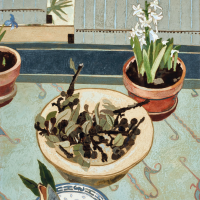04. CRESSIDA CAMPBELL

Now that Cressida Campbell has so completely emerged and has achieved her place as one of Australias most important contemporary artists, it would be impossible to conceive of another painter so involved with the lived environment. She is both painter and print maker and it is between these mediums that her work finds a unique expression. Campbell applies watercolour to a wooden block that she has drawn onto and incised. Once the image is complete, Campbell sprays the surface to activate the paint, and then makes a unique print. It is a sophisticated process, yet describing it, belies the expertise that Campbell brings to her art.
Campbell has various influences. One thinks of Australian painters, Margaret Preston (1875-1963) and Grace Cossington Smith (1892-1984) and French painters, Henri Matisse (1869-1954), and Pierre Bonnard (1867-1947). There is also Campbells collection of prints, drawings and ceramics that informs her practice and often appears in her paintings. Henri Matisse aptly describes this:
My purpose is to render my emotion. This state of soul is created by the objects which surround me and which react in me I express the space and the objects in it as naturally as though I had only the sea and the sky in front of me: that is the simplest thing in the world.1
Gumnuts and Hyacinths 1990, our present lot, goes to the heart of Campbells art by its immediate simplicity. It is an image captured in the everyday flow of things. We are within the norm of tablecloth, plate, hyacinths, and a collection of gumnuts. Campbell has commented on her collecting most recently:
I first gravitated to collecting nuts and acorns. I always liked seeds. And jacaranda pods and any kind of pod. In our garden was an enormous liquidambar tree and I used to collect those little grenades (seed pods). And any kind of leaves, and Id press flowers and plants.2
Campbells eye to the natural world is as successfully realised in her paintings as is her dedication to the arrangement and ultimate composition of her pictures. Gumnuts and Hyacinths is a squared picture, but Campbells paintings may as easily be in vertical or horizontal format, or indeed, the tondo, a recent focus and a challenge the artist handles admirably. The proposition is subject driven and the location, particularly when working indoors, where material is presented in room settings or seen on tabletops, remains paramount.
Naturally, and with the lan of great intimiste painters, Campbell presents an interior world of form that she is drawn to. Here the gumnuts take us to her earliest interest in collecting and taxonomy and to the rockpools she explored with her mother that revealed small crustaceans, shells and crabs. The tablecloth in Gumnuts and Hyacinths is ornate but the colour subdued, and the patterned fabric, a constant in the Campbell lexicon, is laid diagonally to activate the plates and pots that sit upon it. The coup arrives at the edge where cropping of plate and pot eclipses the view, which taken from above, is the final resolution of Gumnuts and Hyacinths.
Footnotes:
1. Henri Matisse, quoted in Hughes, R., The Shock of the New, Thames & Hudson, London, 1991, p.141
2. Cressida Campbell, quoted in Noordhuis-Fairfax, S. (ed.), Cressida Campbell, National Gallery of Australia, Canberra, 2022, p.47
Brett Ballard